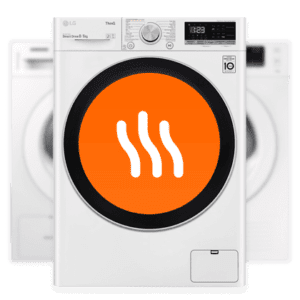Why buy a heat pump dryer
If you’re looking for a new clothes dryer, the heat pump dryer is the way to go. The alternative to the heat pump dryer is the condenser dryer. We’d like to explain the differences between these 2 types of dryers and show you why you should choose a heat pump dryer.
The main difference between these 2 different dryers is that the heat pump dryer uses a heat pump and a refrigerant, while the condensing dryer dries with a heating element. The heating element of the condensing dryer uses a lot of energy, so drying with a heat pump dryer is relatively energy efficient. That’s better for the environment, but also for your wallet. Although heat pump dryers are generally more expensive to buy, they’re often the cheaper choice because of their energy efficiency. Heat pump dryers keep your energy costs nice and low. A heat pump dryer with energy class A+++ can save you up to 888 euros on your energy costs when compared to a condenser dryer with energy class B.
Because the two types of dryers dry your laundry differently, there is also a difference in the drying temperature. The condenser dryer will dry your laundry at a higher temperature. This means shorter drying cycles, but also a greater chance of your clothes wearing out or shrinking due to the hot air. A heat pump dryer will dry at a lower temperature, and therefore take longer, but your clothes will last longer.
These are the benefits of drying with a heat pump dryer:
- It’s better for the environment
- It keeps your energy bills down
- The low drying temperature means your laundry lasts longer< /p>./p>
- Drainage is via a water outlet or reservoir
- These are the disadvantages of buying a heat pump dryer:
- Because of the low temperature, drying programs take longer
- Relatively expensive to buy
Features of heat pump dryer
The heat pump dryer dries your clothes and other laundry using a heat pump and a refrigerant. This makes the drying temperature relatively low, which means it takes longer for your laundry to dry completely. However, the low temperature means that your laundry is less likely to get damaged, which means it will last longer.
The way heat pump dryers dry is energy efficient compared to the condenser dryer. New heat pump dryers almost always have a good energy label; between energy class A+ and A+++. If you want a heat pump dryer that’s energy efficient, it’s best to choose a model in energy class A+++. This will save you up to 888 euros on your energy costs.
The moisture can be removed from heat pump dryers in two ways: collection in a reservoir or removal via the water outlet. Most dryers of this type offer both of these options. If you choose for collection in a reservoir, the moisture is automatically stored in the built-in condensation tray of the dryer. You will need to empty this into the sink after drying your laundry. If you have a water outlet in the room where you will place your dryer, we recommend that you connect it to your new heat pump dryer.
Compare heat pump dryers
Heat pump dryers are the most popular type of dryer today. They dry energy efficiently and often offer a host of options to improve convenience. Because the average heat pump dryer has a lifespan of around 12 years, you’ll want to make sure you get the right one for you and your household. So, here are some tips on how to compare all the different heat pump dryers. The heat pump dryer drains moisture through the water outlet or collects it in a built-in tank. The tank should be emptied after running drying programs, for example in the sink. If you have a water outlet in the room where your heat pump dryer will be installed, we recommend that you connect the heat pump dryer to it. This will save you having to empty the tank after every drying session.
Fill weight
The fill weight of a dryer indicates how many kg of wash fits into the drum. We recommend that you buy a heat pump dryer that has at least the same fill weight as your washing machine. This ensures that all your wet laundry fits into the dryer drum. Are you buying a new heat pump dryer and washing machine? Use the chart below as a guide:
- a household of 1 or 2 people will need a dryer with a fill weight of 7 kg.
- a household of 3 or 4 people will need a dryer with a fill weight of 8 kg. Most heat pump dryers have a rim weight of 8 kg.
- a household of 5 or more people will need a dryer with a rim weight of 9 kg or more.
Energy class
Each time we explained that the heat pump dryer uses less energy during drying than the other types of dryers, due to the use of the heat pump. But there can still be a difference in how energy efficient two different heat pump dryers are. For this, you look at the energy label. The most energy efficient models have energy label A+++, but energy label A++ is also considered energy efficient. A heat pump dryer with an A++ or A+++ energy rating is best for the environment, but also for your energy bill.
Drying programmes
Like your washing machine, heat pump dryers also have several programmes for different types of laundry. There are special programs for wool, shirts, silk, baby clothes and towels. These programs will ensure that your laundry dries perfectly and lasts as long as possible. Almost all new heat pump dryers also have an eco-setting, to further reduce energy consumption during drying, or a setting that makes your laundry ‘extra dry’.
Sound level
The sound level of a dryer indicates how loud it is when it is running its drying cycles. Almost all clothes dryers make a lot less noise than the average washing machine, but the noise can still be distracting. If you want a quiet dryer, you should look for one that produces less than 65 dB (decibels). Heat pump dryers are divided into 3 categories when it comes to noise level: loud (67 dB or more), normal (65 dB or 66 dB) and silent (64 dB and below). Most heat pump dryers are quiet, producing 64 dB or less.
Ease of Use
The heat pump dryer has many smart features that make drying your clothes, bedding and other laundry as easy as possible. These include options such as a self-cleaning condenser, app-based controls, delayed start and an illuminated drum. Do you think you and your household will benefit from this? The build quality of a dryer reflects its robustness and expected lifespan. Looking at build quality, all dryers are divided into basic, mid-range and top-range. If the build quality is not mentioned for a heat pump dryer, the brands and prices can also give an indication. According to the Consumers’ Association, these are the best brands for clothes dryers: Miele, Bosch, Siemens, AEG and Samsung. All these brands have heat pump dryers in their range. The AEG T9DENS87 and AEG T9DEN87CC were the best in this year’s test according to the Consumers’ Association.
The above brands are generally more expensive to buy, so they do not score as well in terms of value for money. Brands that do score well in this category are Beko, Indesit and Zanussi. The Beko DR 8534 GXO was crowned ‘best buy’ for heat pump dryers by the Consumers’ Association. This is because he is relatively inexpensive, energy efficient heat pump dryer.

